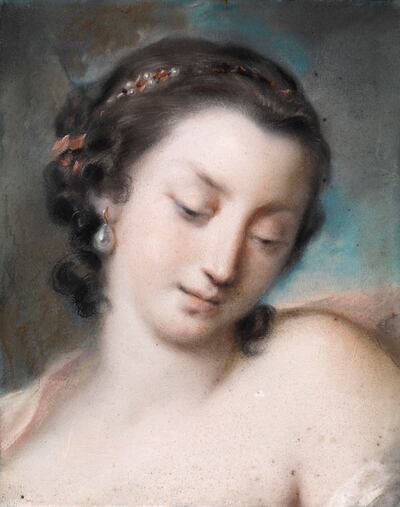It has been almost 30 years since the National Gallery of Ireland staged a dedicated pastel exhibition. One reason is because works in pastel have to be shown sparingly, to prevent their bright colours fading. They are kept under glass to protect their delicate, friable surfaces, while overexposure to light can damage not only the pigments but the paper.
On the New York Metropolitan Museum’s website, senior conservator Marjorie Shelley explains the practical difficulties posed by their fragility. “Vibrations must be avoided (on display, in storage and in transit) because movement risks displacing the pastel powder,” she writes. “Thus, these works demand double crating with special cushioning, and hand tools for framing and installation.”
If an artist wants to create a new colour, one not available even among the wide array of sticks on the market, they can do so by overlapping several strokes of pastel so they blend in the viewer’s eye and appear as if they have been physically combined
You can imagine, then, with what care NGI staff will hang Pastel Revealed, which opens on February 25th and runs until June 5th. The exhibition starts with the 17th-century English portraitist Edmund Ashfield, said to be “the first to use pastel in a genuinely painterly way”, and concludes with recent acquisitions of works by Brian Bourke and William Crozier.
The aim of curators Adrian Le Harivel and Niamh MacNally is to tell the history of the pastel medium, which was re-energised almost two centuries ago by the French artists Millet and Degas, whose work will be among the more than 50 pieces on show. Some are being seen for the first time, while a number of pastels, along with their ornate gilt frames, have been specially conserved so they can be displayed.
READ MORE
These days the word “pastel” is mostly used as an adjective by interior designers describing any soft or delicate shade of colour. In art, however, pastels are coloured crayons made out of pigment mixed with a binder.

“Pastel owes its brilliance and durability to its make-up of pure ground pigments, bound with glue or gum,” say Le Harivel and MacNally. “Pastels retain their brilliance as, unlike oil paintings, they require no varnish, which darkens over time. Due to the ability to produce a sparkling portrait likeness in pastel more quickly than in oil, it attracted both artists and sitters alike.
“Swift execution – along with the ability to render flesh tones, lush fabrics and elaborate accessories – meant that pastel became immensely popular during the 18th century.”
As well as being a quick medium, with no drying time needed, pastels were cheaper than oils, didn’t require solvents, didn’t give off a smell, allowed for frequent interruptions, and there were no brushes to clean afterwards. No wonder they were popular among the early portrait artists who were commissioned by the nobility and upper-middle classes.

Typical was Rosalba Carriera, who will be represented in the National Gallery show by the work Spring, an allegorical personification of the season. Venice-born and probably self-taught, Carriera won international renown for her pastel portraits, with wealthy Grand Tourists among her subjects.
“Her approach was painterly, using pastel to capture the appearance of rich fabrics and dewy skin,” say the curators. “Her mastery of the medium helped transform pastel into a serious and much-admired art form.”
Also in this exhibition will be Hugh Douglas Hamilton’s Portrait of Thomas Roberts. A Dubliner, Hamilton worked for a time in London, where his studio was so busy that he is said to have tossed the clients’ guineas into the pile of broken crayons on the floor. He lived for a dozen years in Italy where he, too, painted many pastel portraits of Grand Tourists. These were also completed at speed for affordable prices.
Though he switched to oil portraits towards the end of his career, such was his association with pastels that the artist was known by the nicknames “Chalk” Hamilton and “Crayon” Hamilton.
“His technique was to apply layers of colour over an outline, adding the final details in graphite,” say the curators. “His small, oval, head-and-shoulder portraits appealed to politicians and aristocrats alike.”
By the time Hamilton died in 1808, the popularity of pastel portraits was on the wane. The medium was revived some decades later by Jean-François Millet, he of “The Angelus” fame. Millet used pastels to brighten up his depictions of peasant life, which made them easier to sell, and his picture A Storm During Haymaking will be in the show. It is one of an estimated 100 works Millet produced while working exclusively in pastel between 1865 and 1869.

Soon afterwards Edgar Degas began to use them in his depictions of ballet dancers. “Handling the crayons like drawing tools, Degas employed a range of linear marks, squiggles, zigzags, and stumped powder, building forms in a broad palette of brilliant, complementary hues – oranges and blues, purples and yellows, reds and greens – applied side by side in thick layers or in overlapping vertical strokes that exposed the underlying colours,” Shelley has written. “These juxtapositions produced vivid contrasts far more powerful and strident than the blended and fused passages of traditional pastelists.”
Degas sent a series of pastel nudes to the final Impressionist exhibition of 1886, where his work hung alongside that of his friend, the American painter Mary Cassatt. Degas had convinced her to work in pastels too, and she eventually made a living in Paris from portraits.
[ Lavery, Turner and trailblazing women at the National GalleryOpens in new window ]
Degas didn’t just use pastels to do studies in advance of oil paintings; he did some of his most important work in the medium, including Waiting, now hanging in the Getty Museum, which depicts a ballerina and her companion before a show. As his eyesight failed, Degas relied on pastels even more, because they let him work closer to the surface, which he sometimes steamed before blending the colours with his fingers.
Pastel Revealed will include the drawing Two Ballet Dancers in a Dressing Room, from about 1880, which has the unorthodox vantage point and framing that were so typical of his work.
“Degas pushed the boundaries of the medium in his endless pursuit to document dance,” say Le Harivel and MacNally. “He was interested in depicting the private moments of dancers before or after a performance, capturing a different kind of intimate movement.”
The curators agree that there has been a historic bias towards oil painting over works on paper, but that does not mean pastel should be regarded as an inferior medium, just different. “Some would say it is more challenging, given the fact that the painter cannot disguise their mistakes,” they point out.
A further appeal lies in pastel’s wide range of colours and the painter’s ability to blend them. Pastels are not mixed together like oils or watercolours. If an artist wants to create a new colour, one not available even among the wide array of sticks on the market, they can do so by overlapping several strokes of pastel so they blend in the viewer’s eye and appear as if they have been physically combined.
That beauty comes at a price: fragility. Denis Diderot, the French philosopher and critic, noted: “The precious powder falls off as easily as scales from a butterfly’s wings”
More recently, the curators say, artists have re-energised pastel by combining it with other media such as graphite, watercolour, colour pencils and crayons to create really striking images. This exhibition will include pastels by artists we don’t associate with the medium at all, such as the French glassmaker Maurice Marinot and that great documenter of mid-20th-century Dublin, Harry Kernoff.
Ultimately, what makes works in pastel so warm and pleasurable are those rich colours. Pastels are “luminous and beautiful beyond all other pictures”, the 18th-century English artist Francis Cotes once enthused.
That beauty comes at a price: fragility. Denis Diderot, the French philosopher and critic, noted: “The precious powder falls off as easily as scales from a butterfly’s wings.” Best take this opportunity to see a fine representative sample, spanning four centuries from the 1670s to 1988, before they disappear back into storage again.
Pastel Revealed is in the Print Gallery of the National Gallery of Ireland from February 25th



















